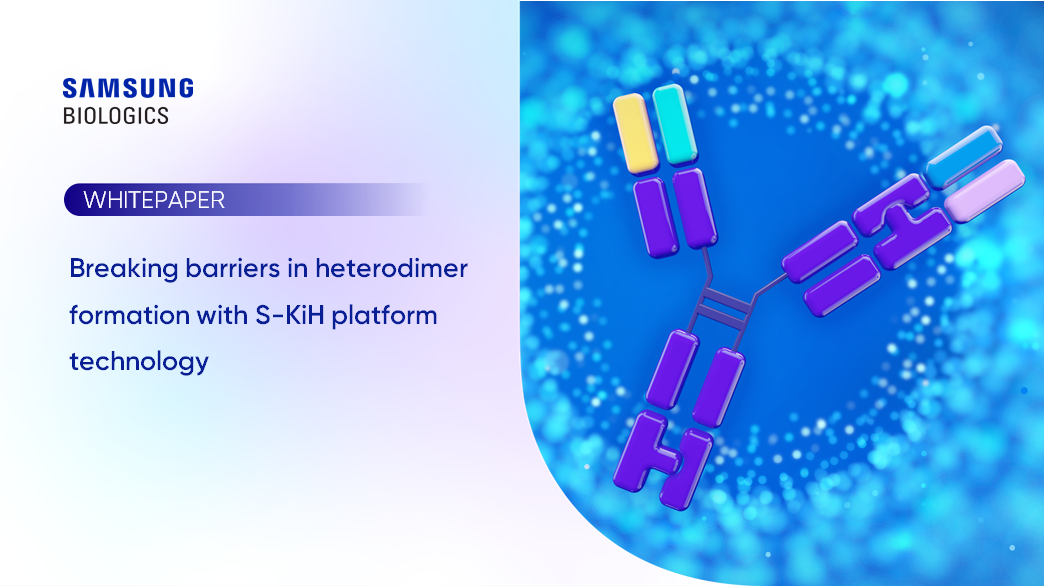Breaking barriers in heterodimer formation with S-KiH platform technology

Market demand for bispecific antibody-based therapies (BsAb) is growing rapidly due to the wide range of applications for these molecules in research and diagnostics. BsAbs can simultaneously bind two separate and unique antigens (or different epitopes of the same antigen) and have shown promise in addressing infectious diseases, autoimmune disorders, and cancer.
As described in our previous article, BsAbs have two different paratopes on variable regions that target two different antigens and are composed of two distinct heavy and light chains (or two distinct heavy chains and common light chains). These distinctive features lead to complex variants, such as protein heterodimers and homodimers different from conventional mAbs. Heterodimer analysis may identify the mispairing of heavy–heavy and heavy–light chains, which can lead to unwanted impurities that are difficult to remove due to their similarity to the desirable form.
In this whitepaper, we show how Samsung Biologics can overcome existing challenges through an advanced knob-into-hold (KiH) technology known as the ‘S-KiH platform,’ which mayl be able to revolutionize the process of heterodimer formation.
Knob-in-hole technology for heterodimer formation
The knob-into-hole (KiH) format was initially composed of knob (T366W) and hole (T366S, L368A and Y407V) mutants located at the CH3 domain interface. In the absence of this format in BsAbs, 16 distinct combinatorial antibody structures can arise from heavy–heavy chain and heavy–light chain mispairing. However, these mutations lead to the alteration of residue packing complementarity between the CH3 domain interface within the structurally conserved hydrophobic core, so heterodimer formation is favored (compared to homodimers).
Despite achieving higher heterodimerization yields through this approach, complete suppression of homodimer formation remained elusive. Moreover, hole–hole homodimer generation hinders the full elimination of product-related impurities. To improve this incomplete strategy, researchers have explored the feasibility of maintaining the hydrophobic core, similar to know-into-hole technology, while improving heterodimer formation by converting the charge complementarity at the surface of the CH3 domain interface. In addition, numerous BsAb developers have sought to enhance performance by exploring diverse CH3 engineering technologies following the expiration of the legacy KiH technology patent.

Market demand for bispecific antibody-based therapies (BsAb) is growing rapidly due to the wide range of applications for these molecules in research and diagnostics. BsAbs can simultaneously bind two separate and unique antigens (or different epitopes of the same antigen) and have shown promise in addressing infectious diseases, autoimmune disorders, and cancer.
As described in our previous article, BsAbs have two different paratopes on variable regions that target two different antigens and are composed of two distinct heavy and light chains (or two distinct heavy chains and common light chains). These distinctive features lead to complex variants, such as protein heterodimers and homodimers different from conventional mAbs. Heterodimer analysis may identify the mispairing of heavy–heavy and heavy–light chains, which can lead to unwanted impurities that are difficult to remove due to their similarity to the desirable form.
In this whitepaper, we show how Samsung Biologics can overcome existing challenges through an advanced knob-into-hold (KiH) technology known as the ‘S-KiH platform,’ which mayl be able to revolutionize the process of heterodimer formation.
Knob-in-hole technology for heterodimer formation
The knob-into-hole (KiH) format was initially composed of knob (T366W) and hole (T366S, L368A and Y407V) mutants located at the CH3 domain interface. In the absence of this format in BsAbs, 16 distinct combinatorial antibody structures can arise from heavy–heavy chain and heavy–light chain mispairing. However, these mutations lead to the alteration of residue packing complementarity between the CH3 domain interface within the structurally conserved hydrophobic core, so heterodimer formation is favored (compared to homodimers).
Despite achieving higher heterodimerization yields through this approach, complete suppression of homodimer formation remained elusive. Moreover, hole–hole homodimer generation hinders the full elimination of product-related impurities. To improve this incomplete strategy, researchers have explored the feasibility of maintaining the hydrophobic core, similar to know-into-hole technology, while improving heterodimer formation by converting the charge complementarity at the surface of the CH3 domain interface. In addition, numerous BsAb developers have sought to enhance performance by exploring diverse CH3 engineering technologies following the expiration of the legacy KiH technology patent.
Related Content